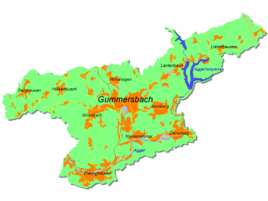Windhagen (Gummersbach)
|
Windhagen
City of Gummersbach
Coordinates: 51 ° 2 ′ 38 ″ N , 7 ° 33 ′ 20 ″ E
|
||
|---|---|---|
| Height : | 289–354 m above sea level NN | |
| Residents : | 1767 (Jun. 30, 2016) | |
| Postal code : | 51647 | |
| Area code : | 02261 | |
|
Location of Windhagen in Gummersbach |
||
Windhagen is a district of the city of Gummersbach in the Oberbergisches Kreis in southern North Rhine-Westphalia .
Location and description
The place is about 2.9 km north of the city center.
history
Beginnings
The name ending -hagen means space enclosed by a hedge in a forest fence . Thus, the emergence of the place can be dated to the great clearing period of the High Middle Ages (11th – 13th centuries). However, the finds of a Neolithic stone chisel and a clay spindle whorl near the railway line in 1919 (both artefacts are in the Rheinisches Landesmuseum in Bonn ) could point to much earlier settlement or at least migration activity in the region.
The nucleus of Windhagen was probably located on the slope above the source of the Gummersbach, since the deeper swampy floodplains were usually settled much later. The addition of the name Wind- could also indicate “airier” properties of the early town center.
First mention
Around 1300 the place was first mentioned in a document around 1450 in a list of wax interest from the Cologne Apostle monastery:
- Henrich to Winthagen et eius sorores (Henrich zu Winthagen and his sisters)
middle Ages
Already in the Middle Ages there was an important court in Windhagen, as it had three castles alone - Feste houses or Kasteele (Low German for forts ), of which all still exist around 1815, today only one (s) exist. Provided with loopholes and bricks, some of which are one meter long, it still suggests that its builders were ready to defend themselves. In 1951 excavations in the vicinity of the castle uncovered a short sword and ceramic shards; the finds were in the 14./15. Dated century.
Population development
| year | Residents |
|---|---|
| 1586 | about 100 |
| 1748 | 151 |
| 1798 | 217 |
| 1863 | 258 |
| 1905 | 547 |
| 1910 | 719 |
| 1980 | approx. 1,800 |
| 2004 | 1,781 |
| 2010 | 1,737 |
Modern times
- The village of Windhagen belonged to the imperial rule of Gimborn-Neustadt until 1806 .
- At the beginning of the 19th century, the road to Hückeswagen was expanded and thus became the first paved road in the Oberbergisches Land , part of today's federal road 256 .
- Around 1920 a large film factory was to be built at the northern exit of Windhagen, financed by the Gummersbach entrepreneurs Bockhacker and Kötitz and the “Allgemeine Deutsche Kreditanstalt”. When inflation set in, however, the plans came to nothing and several hundred workers who had already been employed lost their jobs. For a long time, extensive foundations and parts of the wall on the ground floor were preserved from the ambitious project on an old brick factory.
Churches
- An Evangelical Free Church ( Baptist ) congregation was founded in 1935 after "non-church siblings have been gathering back and forth in the houses in Windhagen for over 60 years". In the same year a chapel was inaugurated, in the place of which a modern community center was built since 1984 . The portal of the chapel is integrated into the south side of the new building.
- Furthermore, the EC community of Gummersbach has its seat in Windhagen. The EG belongs to the Evangelical Society for Germany. It came into being in 2005 from the merger of the two Evangelical Communities in Lower Saxony and Windhagen.
leisure
Association
- Schützenverein Windhagen eV
- Gummersbach volunteer fire brigade , Windhagen fire fighting group
Sports
- Turnverein Windhagen 1913 eV
- FC Windhagen 1923 eV
schools
- Community elementary school Windhagen
Economy and industry
Gummersbach's largest contiguous industrial area is located in Windhagen, the older part of which, "Windhagen-Ost" (70,000 m²; development since the 1980s) is fully marketed. "Windhagen West" (124,000 m²), which is probably the best-known company and houses GIZEH Raucherbedarf GmbH , has already been completely developed and around 70% has been built on.
literature
- Leonard Korth: Wipperfürth. In: Annals of the Historical Association for the Lower Rhine . Issue 51, 1891, pp. 27–103, here pp. 89–91 , (Liber rubeus sheet 59b no. 157a, Cologne City Archives).
Web links
- City of Gummersbach: data, figures, facts.Retrieved on February 26, 2011
Individual evidence
- ↑ Royal Government of Cologne (Ed.): Overview of the constituent parts and list of all the localities and individually named properties of the government district of Cologne, according to districts, mayorships and parishes, with information on the number of people and the residential buildings, as well as the Confessions, Jurisdictions , Military and earlier country conditions. Cologne 1845, p. 29 ( digitized version ).
- ↑ Information on the homepage of the Evangelical Free Church Community, read on March 31, 2010 .
- ↑ Information on the homepage of EG Gummersbach Windhagen, read on September 10, 2012 .

